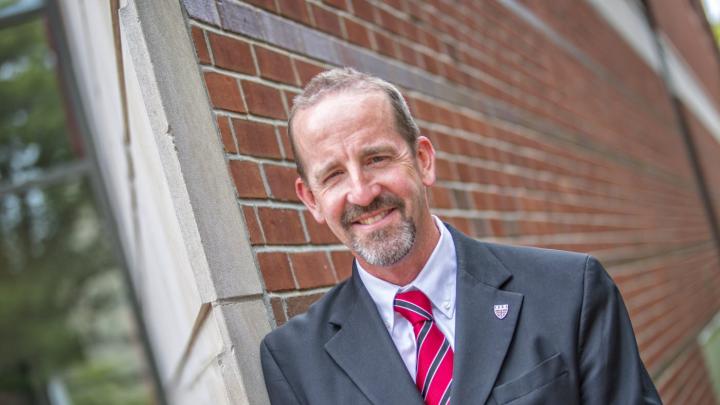The new dean of the Harvard Paulson School of Engineering and Applied Sciences has been in his post for barely a hundred days, but now, after listening to his faculty and meeting with leaders from across Harvard’s diverse schools and constituencies, Francis “Frank” J. Doyle III is starting to form ideas about SEAS’s future.
What attracted him to Harvard, he says, was “a harmonic convergence” of circumstances: the prospect of expansionary growth in Allston; the ability to marshal resources for big initiatives due to “Harvard’s generous alums” (notably, large gifts from Steve Ballmer ’77 and from John A. Paulson, M.B.A. ’80, after whom the school and Doyle’s deanship are now named); an “unusually creative, inquisitive, brilliant study body at the undergraduate and graduate ranks”; and faculty colleagues who are “luminaries in their fields,” but organized in a boundary-free way (SEAS lacks departments) so they “span a continuum of engineering and applied-sciences fields.” This, he says, gives many faculty members a “multidimensional character.”
Doyle himself is multidimensional: the former chair of chemical engineering at the University of California, Santa Barbara, trained in that field, but is now focused predominantly on biosystems engineering (he is on the verge of introducing, through a start-up, an artificial pancreas for the treatment of diabetes, on which he has been working for 20 years). He also teaches in the fields of controls (in its simplest iteration, think of a thermostat on the wall, regulating temperature) and dynamics: an applied math thrust. Off the clock, he referees high-school and college soccer matches; his enormous black watch, equipped with GPS, enables him to overlay the positional data on a map and see how well he is covering the field.
The $400-million gift from Paulson, which Doyle learned about only after accepting the deanship, is much more than a financial resource, he says. “More powerful is the attention that it has brought to engineering as a priority mission here at Harvard. He has shone a giant spotlight on us that has attracted the attention” of students and colleagues not only at the University, but literally, around the world—a “tremendous benefit.”
Now, Doyle sees his job as “helping the faculty to realize the visions and dreams that they have in their individual areas.” He avers that he is “still gathering ideas and thoughts that will help to sculpt a good model for the school,” in order to frame some “grand interdisciplinary challenges that emerge from the faculty’s passion.” Certain of these initiatives will be anchored in Allston, where the school’s new building will begin to rise this coming summer, with a probable occupancy date in 2020. Others will remain in Cambridge.
Some foci, though, are already clear. Computer science, in which he will make 10 senior appointments in the years ahead, will grow in Allston. The department, strong already in the theoretical realm, looks to add expertise in applied directions like machine learning and optimization (developing efficient solutions for problems: a simple example is how to get from point A to point B in the shortest time). Bioengineering is another area poised for growth. Its presence within SEAS is relatively small, but “There is so much more we could do” working with Harvard Medical School, he says, particularly with the quantitative-leaning departments such as systems biology and the newly formed department of biomedical informatics. At a recent meeting with the systems-biology faculty, he reports, he was heartened to hear not only requests for collaboration but an offer: “What can we do for you?”
He sees enormous opportunity, as yet unrealized, for cross-school collaboration. SEAS already offers a collaborative degree with the Graduate School of Design, but Doyle says Harvard has “arguably the world’s leading business school, the world’s leading medical school, and the world’s leading law school,” all with faculty members eager to explore the potential of partnering with engineers. He points as one example to the critical mass of 239 faculty members throughout the University who are working in some way on the climate-change problem. In SEAS and the Faculty of Arts and Sciences alone, he sees a top-10 team of researchers poised to become one of the top three in the country. He envisions taking the efforts of this group to the next level, perhaps even to make it “the number one program in the country.”
As with climate change, “The nature of these big challenges in [engineering] research going forward,” he asserts, “is that they are going to touch on policy issues, legal issues, computing, data-privacy issues.” Personalized medicine, for example, an area that he and “a number of our bio-oriented faculty are interested in,” is bound to affect the healthcare discussion, get into legal issues of privacy, and have an entrepreneurial dimension, thereby involving the schools of business, medicine, law, and public health, in addition to SEAS. These are problems “that require rallying something on the order of a couple hundred people to tackle,” he explains. “We weren’t well-positioned” for these kinds of partnerships in the past. “Today we are.”








